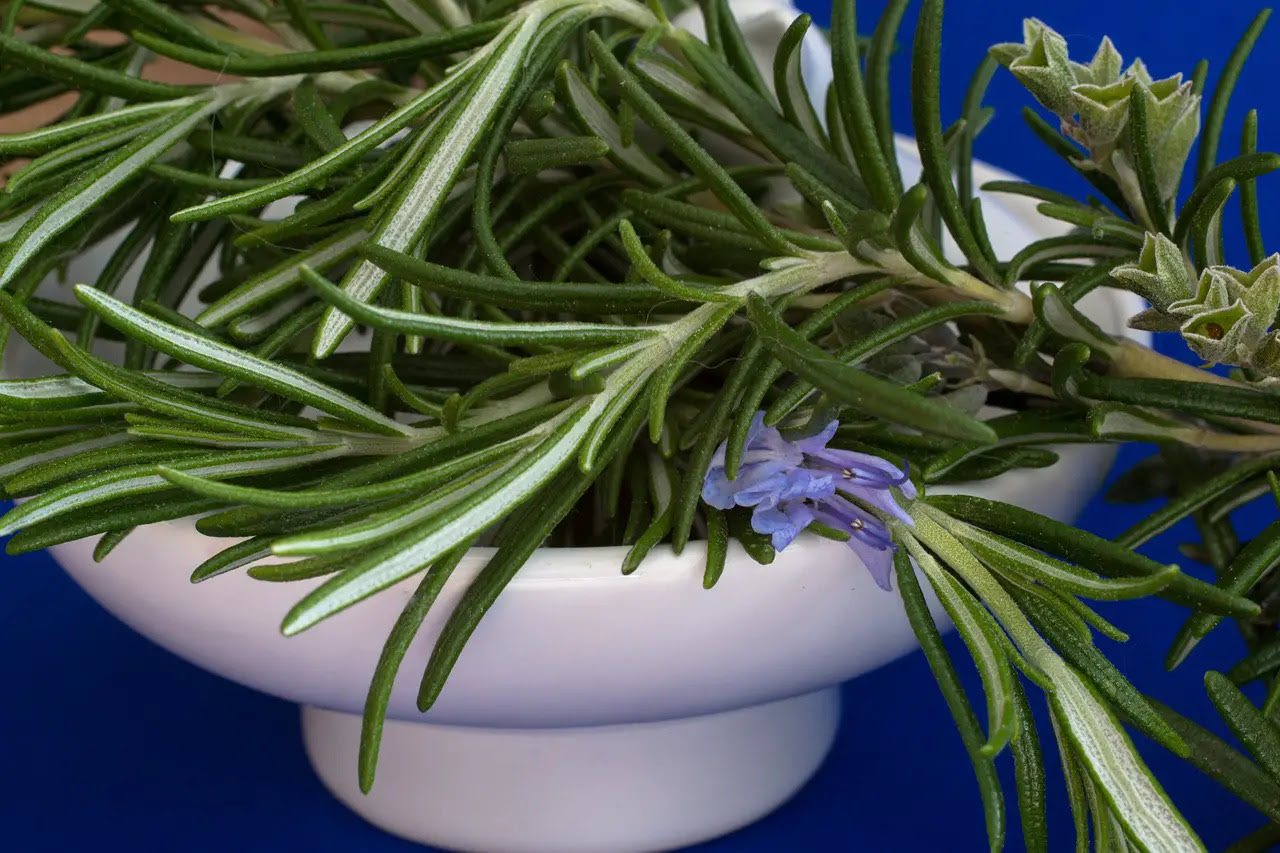Home>Types of Gardening>Edible Gardening>What Is The Difference Between Thyme And Rosemary


Edible Gardening
What Is The Difference Between Thyme And Rosemary
Published: January 31, 2024
Learn the differences between thyme and rosemary for your edible gardening needs. Discover how to grow, care for, and use these popular herbs. Start your herb garden today!
(Many of the links in this article redirect to a specific reviewed product. Your purchase of these products through affiliate links helps to generate commission for Chicagolandgardening.com, at no extra cost. Learn more)
Table of Contents
Introduction
Welcome to the delightful world of herbs, where the aromatic allure of thyme and the robust fragrance of rosemary captivate the senses and elevate culinary experiences. These two perennial herbs are cherished for their distinct flavors, versatile uses, and rich histories. As you embark on this exploration of thyme and rosemary, you will uncover the unique characteristics that set them apart and learn how to harness their culinary and medicinal potential.
Whether you are a seasoned gardener, a budding culinary enthusiast, or someone with a keen interest in natural remedies, understanding the differences between thyme and rosemary is essential. From their appearance and growth habits to their flavor profiles and medicinal properties, each herb possesses its own allure and benefits. By delving into their individual traits, you will gain a deeper appreciation for these beloved herbs and discover new ways to incorporate them into your daily life.
Join us on a sensory journey through the world of thyme and rosemary, where we will unravel the nuances of these beloved herbs and celebrate their contributions to the realms of gastronomy and wellness.
Appearance and Growth
Thyme and rosemary exhibit distinct characteristics in terms of their appearance and growth habits. Thyme, with its small, delicate leaves and low-growing nature, forms dense mats that sprawl across the ground. This herb boasts a variety of cultivars, including common thyme (Thymus vulgaris), lemon thyme (Thymus citriodorus), and creeping thyme (Thymus serpyllum), each offering unique leaf colors and aromas.
On the other hand, rosemary stands tall and proud, gracing gardens with its woody stems, needle-like leaves, and a penchant for reaching impressive heights. The most common variety, Rosmarinus officinalis, features vibrant green foliage and a robust, upright growth habit, making it a striking addition to any herb garden or landscape.
When it comes to growth preferences, thyme thrives in well-drained soil and prefers full sun, though it can tolerate partial shade. Its low-maintenance nature and ability to withstand drought make it an excellent choice for rock gardens, borders, and containers. In contrast, rosemary flourishes in sunny locations with well-draining soil, showcasing its resilience in Mediterranean climates and thriving in coastal regions with minimal humidity.
Understanding the unique growth patterns and environmental needs of thyme and rosemary empowers gardeners to provide optimal conditions for these herbs to flourish. Whether cascading over a rock wall or standing tall in a garden bed, thyme and rosemary offer visual and aromatic splendor, enriching any outdoor space with their distinct charm and vitality.
Flavor and Aroma
The flavor and aroma of thyme and rosemary are the essence of their culinary appeal, infusing dishes with distinctive profiles that elevate the dining experience. Thyme, with its earthy, slightly minty undertones, imparts a subtle yet pervasive flavor that complements an array of dishes. Whether used fresh or dried, thyme lends a gentle warmth to soups, stews, roasted meats, and vegetables, adding depth and complexity to culinary creations.
In contrast, rosemary exudes a robust, pine-like fragrance with hints of citrus, camphor, and a pleasant bitterness. Its assertive flavor profile makes it a versatile herb for seasoning meats, potatoes, bread, and even sweet treats like shortbread and infused syrups. The aromatic intensity of rosemary enriches both savory and sweet dishes, making it a beloved staple in kitchens around the world.
When it comes to pairing with other ingredients, thyme and rosemary each bring their own unique contributions to the table. Thyme harmonizes beautifully with garlic, lemon, and other herbs such as parsley and sage, enhancing the overall flavor profile of a dish. Rosemary, on the other hand, complements bold flavors like garlic, black pepper, and citrus, standing out in meat marinades, roasted vegetables, and artisanal bread recipes.
Exploring the flavor and aroma of thyme and rosemary opens up a world of culinary possibilities, allowing home cooks and professional chefs alike to craft dishes that tantalize the taste buds and create lasting gastronomic memories.
Culinary Uses
Thyme and rosemary are revered in the culinary world for their ability to impart depth, complexity, and a touch of aromatic magic to a wide range of dishes. In the realm of savory creations, thyme shines in hearty soups, stews, and braised dishes, infusing them with a comforting warmth and a hint of floral notes. Its versatility extends to roasted meats, grilled vegetables, and marinades, where it contributes a nuanced layer of flavor that elevates the overall taste profile.
Rosemary, with its bold and assertive nature, is a prized addition to roasted and grilled meats, from succulent lamb and chicken to robust beef and game. Its woody aroma and pine-like flavor make it a standout herb in marinades, herb rubs, and infused oils, enhancing the savory essence of meats and imparting a tantalizing fragrance to the culinary canvas. Additionally, rosemary’s affinity for potatoes and other root vegetables is well-documented, adding a delightful herbal punch to roasted potatoes, oven-baked fries, and rustic vegetable medleys.
Both thyme and rosemary play integral roles in the realm of baked goods, where they bring their unique flavors to bread, pastries, and desserts. Thyme-infused breads and crackers offer a delightful twist on traditional recipes, while rosemary’s compatibility with sweet treats shines in buttery shortbread cookies, citrus-infused cakes, and honey-drizzled fruit tarts.
Furthermore, the combination of thyme and rosemary in culinary applications creates a symphony of flavors, particularly in herb-infused oils, herbaceous rubs for meats, and aromatic seasonings for roasted vegetables. Their compatibility and ability to complement a wide array of ingredients make them indispensable in the culinary landscape, inspiring creativity and enhancing the dining experience with their aromatic allure.
Medicinal Uses
Beyond their culinary prowess, thyme and rosemary have been valued for centuries for their medicinal properties, offering a treasure trove of health benefits and therapeutic applications. Thyme, revered for its antiseptic and expectorant properties, has been traditionally used to alleviate respiratory ailments such as coughs, bronchitis, and congestion. Its essential oil, rich in thymol, lends itself to natural remedies for sore throats and respiratory discomfort, often found in herbal lozenges, teas, and steam inhalations.
Rosemary, with its aromatic compounds and antioxidant properties, has been celebrated for its potential to enhance cognitive function, memory retention, and overall mental acuity. The invigorating aroma of rosemary has been linked to improved focus and mental clarity, making it a popular choice for aromatherapy and herbal infusions aimed at promoting mental wellness.
Both thyme and rosemary contain essential oils that possess antibacterial and antimicrobial properties, making them valuable allies in supporting immune health and combating microbial threats. Whether used in herbal tinctures, teas, or topical applications, these herbs offer natural alternatives for bolstering the body’s defenses and promoting overall well-being.
Furthermore, the anti-inflammatory properties of thyme and rosemary make them valuable components in topical preparations, such as infused oils, salves, and balms. These applications are often utilized for soothing sore muscles, easing joint discomfort, and promoting relaxation through massage and aromatherapy.
As with all herbal remedies, it is important to seek guidance from qualified healthcare professionals before integrating thyme and rosemary into medicinal routines, especially if individuals have pre-existing health conditions or are taking medications. By harnessing the medicinal potential of these herbs responsibly, individuals can explore natural avenues for supporting their health and well-being.
Conclusion
Thyme and rosemary, with their distinct characteristics and versatile attributes, stand as pillars of culinary and medicinal excellence, enriching our lives with their aromatic splendor and holistic benefits. From the sun-kissed slopes of the Mediterranean to herb gardens and kitchen windowsills around the globe, these herbs have woven themselves into the tapestry of human history, leaving an indelible mark on our palates and well-being.
As we have explored the nuanced differences between thyme and rosemary, it becomes apparent that their individual charms and contributions extend far beyond mere flavoring agents. They are storytellers of ancient traditions, bearers of natural remedies, and catalysts for culinary creativity. Their presence in gardens and kitchens serves as a reminder of the symbiotic relationship between humans and the plant kingdom, where mutual enrichment and nourishment abound.
Whether adorning a savory roast, steeping in a soothing tea, or lending their fragrance to a healing salve, thyme and rosemary continue to captivate and inspire, inviting us to embrace their timeless allure and harness their bountiful offerings. As we savor their flavors and unlock their healing potential, let us honor these botanical treasures and celebrate the enduring legacy of thyme and rosemary in our lives.









